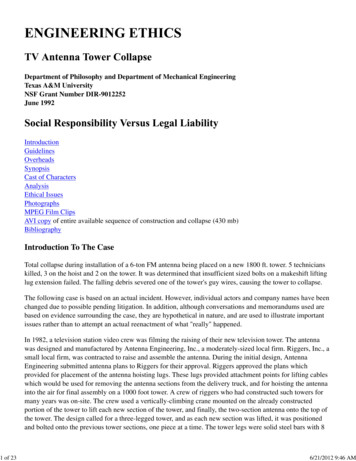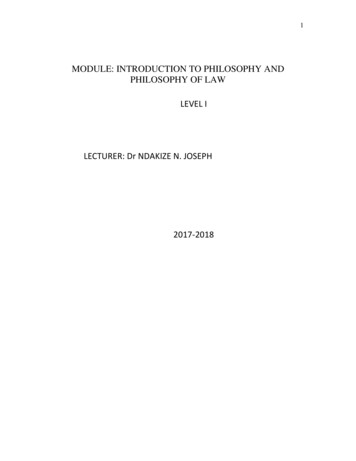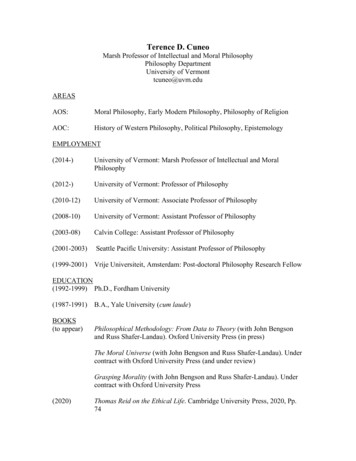
Transcription
1 of 23Department of Philosophy and Department of Mechanical EngineeringTexas A&M UniversityNSF Grant Number DIR-9012252June 1992IntroductionGuidelinesOverheadsSynopsisCast of CharactersAnalysisEthical IssuesPhotographsMPEG Film ClipsAVI copy of entire available sequence of construction and collapse (430 mb)BibliographyIntroduction To The CaseTotal collapse during installation of a 6-ton FM antenna being placed on a new 1800 ft. tower. 5 technicianskilled, 3 on the hoist and 2 on the tower. It was determined that insufficient sized bolts on a makeshift liftinglug extension failed. The falling debris severed one of the tower's guy wires, causing the tower to collapse.The following case is based on an actual incident. However, individual actors and company names have beenchanged due to possible pending litigation. In addition, although conversations and memorandums used arebased on evidence surrounding the case, they are hypothetical in nature, and are used to illustrate importantissues rather than to attempt an actual reenactment of what "really" happened.In 1982, a television station video crew was filming the raising of their new television tower. The antennawas designed and manufactured by Antenna Engineering, Inc., a moderately-sized local firm. Riggers, Inc., asmall local firm, was contracted to raise and assemble the antenna. During the initial design, AntennaEngineering submitted antenna plans to Riggers for their approval. Riggers approved the plans whichprovided for placement of the antenna hoisting lugs. These lugs provided attachment points for lifting cableswhich would be used for removing the antenna sections from the delivery truck, and for hoisting the antennainto the air for final assembly on a 1000 foot tower. A crew of riggers who had constructed such towers formany years was on-site. The crew used a vertically-climbing crane mounted on the already constructedportion of the tower to lift each new section of the tower, and finally, the two-section antenna onto the top ofthe tower. The design called for a three-legged tower, and as each new section was lifted, it was positionedand bolted onto the previous tower sections, one piece at a time. The tower legs were solid steel bars with 86/21/2012 9:46 AM
2 of 23inch diameters. The tower sections weighed approximately 10,000 pounds and were each 40 feet long. Theywere raised without incident to a height of about 1000 feet.The two final antenna sections arrived at the site and assembly proceeded as planned, until the last antennasection was ready to be hoisted into position. This section was different from the other sections of the antennabecause it had microwave baskets attached to the sides of the antenna. The placement of the hoisting lugsallowed the antenna to be lifted horizontally off of the delivery truck, but the baskets interfered with thelifting cables when the antenna was rotated to a vertical position. A make-shift extension to the lifting lug hadto be fashioned by the riggers to permit the last section's vertical hoisting. Unfortunately, on the day ofvideotaping during the hoisting of this last section, something went wrong, and while the antenna was beinghoisted, the bolts on the make-shift lifting lug extension failed. The result was a tragedy. Several riggers fell1000 feet to their death.The video camera caught this catastrophe on film, and through its footage, investigators were able to discoverwhere the failure initiated, and why the accident occurred. The case of the antenna tower collapse raisesserious questions about the design engineer's social responsibility to ensure safety on the construction site,and poses additional questions about product liability issues in engineering and ethics.Ethical issues raised by the case involve social responsibility versus legal liability, engineering responsibilityfor failed innovation, problems associated with design implementation, and liability and negligence issues.While valuable for all engineering students, the case is particularly well suited for statics, constructionengineering and structures courses.Guidelines For Presentation1. Prior to class discussion, show video: Missouri City, Texas, TV Antenna Tower Collapse. The videomay be borrowed from the authors of this report for copying purposes. After the video, distribute thestudent handout: Missouri City, Texas TV Antenna Tower Collapse: Social Responsibility Versus LegalLiability. Have students come to the discussion class prepared to address the technical and ethicalissues raised in the student handout.2. In the discussion, present overheads: 1) through 4): The Cast of Characters and Problem Presentation,Model Riggers Thought Was Correct, Model Riggers Should Have Used, and Free Body Diagram ofLifting Bar and Analysis of Riggers' Solution, respectively.3. End the discussion class with Overhead 5), TV Antenna Tower Collapse: Ethical Issues of the Case.Discuss the ethical issues of the case:Where does the responsibility of Antenna Engineering end and Riggers begin? Should AntennaEngineering have provided adequate hoisting lugs in their original design?Should Riggers have looked at the original design more carefully?Should Antenna Engineering have allowed Riggers to remove the microwave baskets?Should Riggers have devised their own hoisting solution without consulting another engineer? What istheir responsibility for contracting a consulting engineer?Should Antenna Engineering have recommended another consulting engineer to assist Riggers? Shouldthey have notified their professional society? Was it ethical for the engineers at Antenna to wash theirhands of the project without attempting to find a resolution for Riggers? What other measures couldthey have taken to assist Riggers without becoming legally entangled?Should Antenna Engineering have refused to review the new hoisting design?6/21/2012 9:46 AM
3 of 23If social responsibility comes before legal liability, surely there were other things Antenna Engineeringcould have done. What would you do in a similar situation?Instructors preparing to lead class discussion on this case will find particularly relevant essays #4,"Engineering Design: Literature on Social Responsibility Versus Legal Liability," and #5, "Negligence, Risk,and the Professional Debate over Responsibility for Design," both appended at the end of the cases in thisreport. In addition, essays #1 through #3 appended at the end of the case listings in this report will haverelevant background information for the instructor preparing to lead classroom discussion. Their titles arerespectively: "Ethics and Professionalism in Engineering: Why the Interest in Engineering Ethics?;" "BasicConcepts and Methods in Ethics;" and "Moral Concepts and Theories."Recommended Overheads1) The Cast Of Characters & Problem Presentation2) Model Riggers Thought Was Correct3) Model Riggers Should Have Used4) Free Body Diagram of Lifting Bar and Analysis of Riggers' Solution5) TV Antenna Tower Collapse: Ethical Issues Of The CaseThe Cast of CharactersAntenna Engineering, Inc. Designed and Built the AntennaWilliam (Bill) Harris -- President. Harris recommended to Jordan that Antenna Engineering, Inc. not getinvolved with Riggers problems regarding lifting the antenna tower, due to legal liability issues.Harry Jordan -- Head of the Engineering Division. Jordan told Riggers that they could not authorizeremoving the microwave baskets, yet he also told Riggers that the engineering firm signed off responsibilityonce Riggers accepted their design plans.Riggers, Inc.: Contracted to Assemble the AntennaFrank Catch -- President.Randall Porter -- Vice President. Made initial call to Antenna Engineering, Inc., detailing the problemsRiggers was having lifting the top antenna section with the microwave baskets on it.Bob Peters -- Lead Lift. One of the workers killed in the collapse.Kevin Chapp -- Cable Operator. Talked to Peters before the catastrophe, asking about the safety of theoperation.The Problem:6/21/2012 9:46 AM
4 of 23Riggers, Inc. could not hoist the last antenna section using the lifting lugs Antenna Engineering provided dueto interference with microwave baskets. Antenna Engineering refused permission for Riggers to remove thebasket and reassemble after hoisting.Analysis of the Antenna LiftMODEL RIGGERS THOUGHT WAS CORRECTCalculation of stress in bolts Total Antenna Weight / (2 * Total Bolt Cross-sectional Area)MODEL RIGGERS SHOULD HAVE USED:FREE BODY DIAGRAM OF LIFTING BAR AND ANALYSIS OF RIGGERS' SOLUTION6/21/2012 9:46 AM
5 of 23Assuming that the angle that the tower hangs is relatively small, which it was, and that the bolts were about 1foot apart, and that the supporting channel was about 6 feet long, the load in the bolts is actually acombination of direct shear (as found previously, plus the load due to the moment caused by the length of thechannel. Thus:Sum of Moments about the bolt on the left end of the channel 0 Weight of antenna * 6 feet - Added force in bolt * 1 foot, such thatAdditional force in bolt 6*weight of antenna, which when added to the direct force of 1 * Weight ofAntenna gives a total load on the right hand antenna bolt of 7*Antenna Weight.The corresponding shear stress on each bolt is thus: Stress (7*Antenna Weight)/Area of boltor, in other words, the stress (for these assumed numbers) in the bolts is seven times what the Riggers thoughtit would be.Ethical Issues Of The Case - Points for Discussion1) Where does the responsibility of Antenna Engineering end and Riggers begin? Should AntennaEngineering have provided adequate hoisting lugs in their original design?2) Should Riggers have looked at the original design more carefully?3) Should Antenna Engineering have allowed Riggers to remove the microwave baskets?4) Should Riggers have devised their own hoisting solution without consulting an engineer? What is theirresponsibility for contracting a consulting engineer?5) Should Antenna Engineering have recommended another consulting engineer to assist Riggers? Shouldthey have notified their professional society? Was it ethical for the engineers at Antenna to wash their handsof the project without attempting to find a resolution for Riggers? What other measures could they have takento assist Riggers without becoming legally entangled?6) Should Antenna Engineering have refused to review the new hoisting design?7) If social responsibility comes before legal liability, surely there were other things Antenna Engineeringcould have done. What would you do in a similar situation?6/21/2012 9:46 AM
6 of 23SynopsisThe following case is based on the actual incident. However, individual actors and company names have beenchanged due to possible pending litigation. In addition, conversations and memorandums used are based onevidence surrounding the case; however, they are hypothetical in nature, and used to illustrate importantissues involved in the case rather than to attempt an actual reenactment of what "really" transpired.During the construction of a major TV tower/antenna, a television station video crew was filming theconstruction. Their station was to use the antenna to extend their station's range, and they would film theoperations daily for use in their news broadcasts. The antenna was designed by Antenna Engineering, Inc.Riggers, Inc. (a small local firm) was contracted to raise and assemble the antenna. During the initial design,Antenna Engineering submitted plans to Riggers for their approval. Riggers approved the plans whichprovided for placement of several hoisting lugs. These lugs provided attachment points for lifting cableswhich would be used for removing the antenna sections from the delivery truck, and for hoisting the antennasections into the air for assembly. A crew of seven riggers who had constructed such towers for many yearswas employed. The crew used a vertical climbing crane, mounted on the already-constructed portion of thetower to lift each section of the antenna into the air. The design called for a three-legged tower. Each sectionwas lifted and strapped onto the tower, one piece at a time. The anchor points for these sections were veryaccurately set.The antenna sections arrived at the site and assembly proceeded as planned, until the last antenna section wasready to be hoisted into position. This section was different from the other sections of the antenna, because ithad microwave baskets attached to the side of the antenna. The placement of the hoisting lugs allowed theantenna to be lifted horizontally off of the delivery truck, but the baskets interfered with the lifting cableswhen the antenna was rotated to a vertical position for bolting onto the previous section. Riggers calledAntenna requesting redesign assistance to fix the problem, but Antenna declined. Riggers then requestedpermission to remove the microwave baskets to clear the lifting cables, which was refused. A make-shiftextension to the lifting lug had to be fashioned by the riggers to permit the last section's vertical hoisting.When the last section was hoisted, something went wrong. The bolts on the make-shift lifting lug extensionfailed while the antenna was being hoisted. The result was a tragedy. Several riggers fell 1000 feet to theirdeath.The video camera caught this catastrophe on film, and through its footage, investigators were able to discoverwhere the antenna debris landed and why the accident occurred. The case of the antenna tower collapse raisesserious questions about the design engineer's responsibility to ensure safety on the construction site and posesadditional questions about product liability issues in engineering ethics.Individuals Involved In The TV Antenna Tower Collapse CaseAntenna Engineering, Inc. Designed and Built the AntennaWilliam (Bill) Harris -- President. Harris recommended to Jordan that Antenna Engineering, Inc. not getinvolved with Riggers' problems regarding lifting the antenna tower, because they might incur liability.Harry Jordan -- Head of Engineering Division. Jordan told Riggers that they would not authorize removingthe microwave baskets, yet he also told Riggers that the engineering firm was no longer responsible, once6/21/2012 9:46 AM
7 of 23Riggers accepted their design plans.Riggers, Inc.: Contracted to Assemble the AntennaFrank Catch -- President.Randall Porter -- Vice President. Made the initial call to Antenna Engineering, Inc., detailing the problemsRiggers was having lifting the top antenna section with the microwave baskets on it.Bob Peters -- Lead Lift. One of the workers killed in the collapse.Kevin Chapp -- Cable Operator. Talked to Peters before the catastrophe, asking about the safety of theoperation.Analysis of the Faulty DesignIn 1982, an antenna was designed and manufactured by Antenna Engineering, Inc. (a moderately-sized localfirm). Riggers, Inc. (a small local firm) was contracted to raise and assemble the antenna. During the initialdesign, Antenna Engineering submitted plans to Riggers for their approval. Riggers approved the plans whichprovided for placement of the hoisting lugs. These lugs provided an attachment point for lifting cables whichwould be used for removing the antenna sections from the delivery truck, and for hoisting the sections intothe air for assembly.On November 18, 1982, Riggers called Antenna Engineering and asked if it was acceptable to remove themicrowave baskets on the top 100-foot section of the tower so they could lift the antenna into position, andthen reinstall the baskets after the section was in place. Antenna Engineering told Riggers that removing thebaskets would void the warranty. At a previous job Antenna Engineering had allowed removal of themicrowave baskets and they were not reinstalled properly. Antenna Engineering was held responsible forcorrecting the problem, which cost them a great deal of money. The following telephone conversation tookplace between Randall Porter, Riggers' vice president, and Harry Jordan, Antenna Engineering's engineeringdivision head:Porter: Harry, this is Randall Porter with Riggers, Inc. We've run into a problem on Tower 17.Jordan: How so?Porter: Well, thus far everything has been fine, but the top antenna section has the lifting ears in such aposition that we can't cable them up to the crane without running into the microwave baskets.Jordan: Well, we put them on as specified on the plans. Seems like they were right between two baskets,weren't they?Porter: Yes, and that works great getting it off the truck, but when we try to get it on top of the previousantenna section, it has to be lifted vertically. The crane is barely able to get the antenna up high enough tobolt it to the preceding section as it is. No way can we lift it to the top horizontally.Jordan: Well, what do you suggest? We pretty well signed off when you accepted the plans, and don't haveany connection with the construction of the antenna. We leave getting it up in the air pretty much to you guys.Not that we don't want to help in any way we can, but you and your people put these towers up every day ofthe year, and we really don't want to start getting into that area.6/21/2012 9:46 AM
8 of 23Porter: No, I understand that, but it's just that we really don't have an engineer on our staff who can redesignthose little ears and put them in a location that will work. So what we would like to do is simply take off thebaskets until we get the antenna in the air and bolted down on top. Our guys will then take the baskets up andbolt them on. Should be no problem, but we just wanted to check with you first.Jordan: I don't know Randall. We took a beating on letting some other company remove those baskets lastyear. You wouldn't believe what a mess birds can cause when those microwave guides are left open. It took us6 months and a small fortune to purge out nests, rats, sand you name it. That's why you get the antennasection with the microwave baskets all bolted on and sealed, to prevent that.Porter: We would take full responsibility for not letting that happen. You could make us some blanking platesto replace the baskets, and we would leave them on until we were ready to put them back on. Surely we canwork something out, because that section is due to go up tomorrow, and we don't have a clue how we're goingto do it.Jordan: Well let me talk to Bill about it, but I'll tell you now, he is absolutely rabid about removing thebaskets once they are sealed. How's business down there?Porter: We're always busy - got a job coming up in Louisiana next week so we're really pressing thecompletion of 17. Listen, be sure and call me on this, OK?Jordan: I'll get right on it, Randall. See you.Porter: Bye.While Riggers requested the help of Antenna Engineering to determine how to lift the antenna withoutremoving the microwave baskets, Antenna Engineering responded by stating that their job was to design andbuild the antenna, and Riggers was responsible for assembly. Following his conversation with Porter, Jordandrafted a memorandum to Antenna Engineering's president, William Harris:Interoffice Memo, November 18: Bill Riggers, Inc., says they will be unable to use the designed lifting earsfor little other than getting the upper section off the truck. The present position causes the lifting cables tostrike the microwave baskets when the antenna is rotated vertically for bolting on to the previous section.They are asking that we let them take the baskets off until the section is in place. What do you think?Harris' response is captured in a November 19 conversation with Jordan:Harris: Morning Harry. I got your memo when I got back from Tampa last night. I'm really surprised that youdidn't just tell them "no way" when they called.Jordan: Yeah, I knew you weren't going to be happy with their request, but they do have a problem, and Ithought it would be best for you to decide.Harris: Listen pal, you and I just dropped a quarter million bucks letting some clown mess with the basketson our last job. And for what? A dead rat and some bird droppings. I mean that kind of trash really messes upwave guides, and these guys just cannot be trusted to do anything but make a mess of them. Now they knowthat the contract they signed said they would not touch those baskets during construction, and that thewarranty was void the minute they did. And if you think they have a quarter million to fix the problems theymight cause, you have another think coming. No way. We would be right back in court just like last time, andyou know it.6/21/2012 9:46 AM
9 of 23Jordan: Well, what about redesigning the whole rig, so that they could grab onto something which extendsoutside the baskets?Harris: How about letting them do that? I'll tell you Harry, I'm really not into getting into their business. Theyhave put up over a hundred of these towers, they say they are the experts in this field, so let them put thedanged thing up. That's what they're paid to do. Believe you me, if this antenna doesn't have the field ofcoverage we say it should, they sure as heck aren't going to help us take it down and redesign it. By the sametoken I really don't think you and I should get into their field of expertise and start telling them how to get itin the air. Do you want to take on that legal responsibility? Man if that thing ever fell down, and we had somuch as suggested their method of lifting it, or redesigned any part of it - even if it had nothing to do withour design - you can be sure we would be right in the middle of a court battle. No way. They are the expertsin construction, let them construct.Jordan: You're probably right. How did the Florida trip go? .Thus, Riggers devised their own solution, without consulting an engineer, although they did request a reviewof their plans by Antenna Engineering. This request by Riggers for review was refused by AntennaEngineering due to their potential liability in the event of a mishap if they had commented on the plans. OnNovember 20, the following conversation took place between Riggers' president, Frank Catch and hisvice-president, Randall Porter:Porter: Frank, Harry over at Antenna Engineering called about the lifting ears on the upper antenna, andthey're just not willing to get into it at all. They're worried that if we take off the baskets some kind of junkmay get in and ruin the whole thing. They say that the warranty is void if we so much as unbolt one of thebaskets. They're really not being very helpful about redesigning the lifting lug either.Catch: I was afraid that would be the case. Not that I can really blame them. They want to sit in their officeand let us take all the chances out here in the field. But I guess that's what they pay us for. Anyway, whatnow?Porter: Well, I guess we could stick a channel across two of the two legs, and bolt it to the antenna with someU-bolts. A channel would stick out far enough to let the cables clear the baskets. The section weighs aboutone thousand pounds, and each U-bolt is rated at twelve hundred, so if we use a couple of them that should beOK.Catch: I would hope. Have you got everything you need?Porter: Pretty much, but if not it won't be hard to get locally.Catch: OK. Is everyone packed up and ready for the next job in Louisiana?Porter: Pretty much .Riggers attached a long channel to the antenna section with several U-bolts. By attaching the lifting cables tothe end of the added steel section the antenna section could be raised vertically without interference from themicrowave baskets. They used bolts that they thought were of the proper strength, and figured in a factor ofsafety, but they did not realize that the piece of steel they attached also added a large moment which wastransmitted through the U-bolts. Figure 1 shows what Riggers, Inc. thought was the correct model and Figure2 shows the model that should have been used.6/21/2012 9:46 AM
10 of 23In Figure 1, the shear stress in each of the bolts is Antenna Weight/(2*Abolt). Figure 2 shows the properanalysis, involving summation of moments around the center of the left hand bolt. The moment equations arethen used to determine the force applied to each bolt. Dividing the force applied to each bolt by the bolt'scross-sectional area will give the shear stress acting on the bolt:Only hours before the accident, the following conversation took place on-site between Kevin Chapp, Rigger'scable operator and Bob Peters, Riggers' lead lift.Chapp: Well, what's the verdict?Peters: Looks like the wind will be below the limit, so we'll go up. Sure is foggy though. These radios are alifesaver when you can't see the ground.Chapp: I never ran tag lines before radios, so I wouldn't know. Before my time. How did you get yourinstructions down before that?Peters: Did a lot of yelling, but they weren't nearly as tall then either.Chapp: Dang that thing is really up there, huh. I don't envy you up there. I'd be scared to death. Have youever had one of these things fall?Peters: I've had close friends on one that came down, and was in the vicinity of one that blew down in astorm while it was going up, but that's about all. It's not really the extra height that gets you. You're just asdead if you fall 100 feet as you are from 1000 feet.Chapp: Some of the guys were kidding around last night about if they were on a tower and it fell should youunbuckle your belt and jump, or stay strapped on.Peters: Got me. OSHA would probably fine you if you didn't stay belted.Chapp: Ready for the next one?Peters: Yep. Hey - I've got my dog in the car, checked out of the motel, got the car packed and everything.Would you let him out and watch out for him? I'd hate to have him locked in there all morning.Chapp: Sure, but when we get really busy back he goes. There's our TV camera man. He has been out herealmost every day now, taking pictures. What's that for?Peters: I think they are keeping a record of it on the news as it goes up. Like a documentary.Chapp: Who is going up today?Peters: It will take four of us - two on the antenna to keep it lined up, and two on the tower to receive it. We'llbe through about 2 or 3 this afternoon, and be at the next job tonight.But they never made it to the next job. The antenna collapsed catastrophically when the bolts failed while theantenna was being hoisted. All four people lost their lives in the accident, in addition to another riggerworking on the construction site. When they found the bolts (by viewing the videotape) and ran tests, theshear strength of the bolt material was half of what it should have been. Thus, the bolt manufacturer wassued, while Antenna Engineering suffered no monetary loss for the accident. A year before the accident, thebolt manufacturer received a lot of bad publicity due to another substandard bolt. They did not need another6/21/2012 9:46 AM
11 of 23messy case, so they settled out of court and the case was closed.The public has become increasingly aware that benefits of industrial progress must be measured against thegrowing concern that someone must protect the public from damages caused by the products and by-productsof technology. Naturally, the spirited, and swelling public debate puts engineers at the center of the productsafety and social responsibility versus legal liability controversy. As such, this case raises questions about theengineering firm's social responsibility versus its legal liability. What alternatives could have been employedso that seven riggers would not have lost their lives?Ethical Issues Of The Case - Points For DiscussionHow do the ethical obligations between engineering professionals and the public apply in the TV AntennaTower Collapse case?At first glance it appears that Riggers was responsible for devising a lifting scheme that was technicallyflawed, and then implementing that scheme at the cost of seven lives. Yet, as engineers test designs forever-increasing speeds, loads, capacities and the like, they must remember their social obligations to protectthe public welfare. After all, the public has provided engineers, through the tax base, with the means forobtaining education, and through legislation, with the means for licensing and regulating themselves. Inreturn, engineers have a responsibility for protecting the safety and well-being of the public in all of theirdesign efforts. This is part of an implicit social contract all engineers agree to when they accept admission toan engineering college.The design company engineers knew they had to provide an adequately designed hoisting lug on the finalantenna section, and they did; however, the lug was sufficient only for lifting the antenna section off thedelivery truck and placing it on the ground. Due to the placement of the lugs in relation to the microwavebaskets, the hoisting lugs were useless for lifting the section 1,000 feet to the top of the tower. One mightargue that the hoisting lug design was, in truth, inadequate. On the other hand, Antenna Engineering showedthe antenna plans to Riggers, Inc., before the antenna was built. When Riggers looked at the plans theyshould have realized that the placement of the hoisting lugs was poor. But, employees of Riggers, Inc. did nothave the same technical expertise as those at Antenna Engineering. They were skilled tradespeople, notprofessional engineers. They had raised 30 other towers in like manner prior to the Missouri City catastrophe.After the antenna was delivered to the construction site, Riggers went to Antenna Engineering and asked theirpermission to remove the microwave baskets from the antenna section to permit hoisting of the section usingthe lifting lugs provided. Riggers promised to remount the baskets once the section was in place at the top ofthe tower. Antenna Engineering flatly refused permission for this proposal. They cited previous examples ofother rigging companies damaging their antenna baskets during hoisting and having to fix the basketsthemselves, at their expense.
Department of Philosophy and Department of Mechanical Engineering Texas A&M University NSF Grant Number DIR-9012252 June 1992 Introduction Guidelines Overheads Synopsis Cast of Characters Analysis Ethical Issues Photographs MPEG Film Clips AVI copy of entire available sequence of construction and collapse (430 mb)











